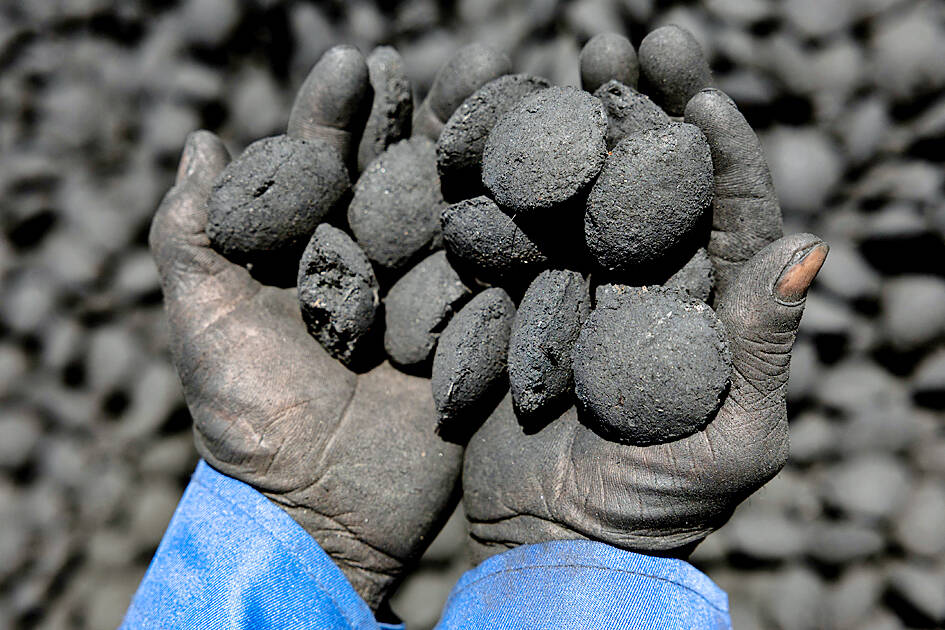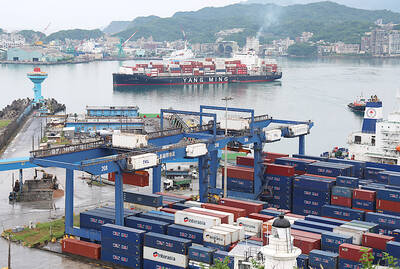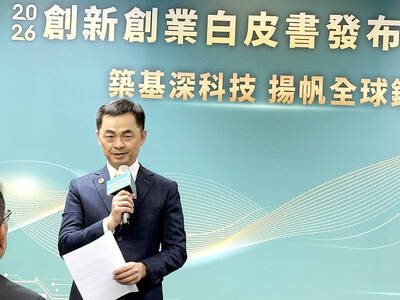As they zigzagged from one machine to another in the searing African sun, the workers were covered in black soot.
However, the charcoal they were making is known as “green,” and backers hope it can save impoverished Chad from rampant deforestation.
Chad, a vast, landlocked country of 19 million people perched at the crossroads of north and central Africa, is steadily turning to desert.

Photo: AFP
It has lost more than 90 percent of its forest cover since the 1970s, hit by climate change and overexploitation of trees for household uses such as cooking, officials say.
“Green charcoal” aims to protect what forest is left.
Made from discarded plant waste such as millet and sesame stalks or palm fronds, it is meant to save trees from being chopped down for cooking.
The product “releases less emissions than traditional charcoal, it doesn’t blacken your pots, it has high energy content and lasts up to three times longer than ordinary charcoal,” Raikina Association for Socioeconomic Development (Adser) technical director Ousmane Alhadj Oumarou said.
“Using 1kg of green charcoal saves 6kg of wood,” Oumarou said.
The group has installed a production facility in Pont Belile, just north of the capital, N’Djamena.
There, workers grind up burnt plant waste, then mix it with gum arabic, which helps it ignite, and clay, which makes it burn more slowly.
The resulting black nuggets look like ordinary charcoal.
Like the traditional kind, it emits carbon dioxide when it burns — but less, University of N’Djamena ecologist Souleymane Adam Adey said.
“It contributes to fighting deforestation, by ensuring the trees that aren’t cut down continue to capture and store carbon,” he said.
The conflict in neighboring Sudan, which is facing one of the worst humanitarian crises in the world, is adding to pressure on Chad, which has become home to more than 800,000 Sudanese refugees since 2023 — double the 400,000 it already hosted.
“Desertification has progressed in the regions that have been hosting Sudanese refugees for the past two years,” said Adser director Ismael Hamid, a 45-year-old businessman.
Adser invested 200 million CFA francs (US$351,394) to launch the project, then won backing from the World Bank, which buys the charcoal for 750 CFA francs per kilogram.
The UN High Commissioner for Refugees distributes the charcoal in refugee camps in eastern Chad.
However, Hamid said he hoped to expand production and slash prices to 350 to 500 CFA francs per kilogram to make “green charcoal” available and affordable nationwide.
The plant produces 7 to 9 tonnes per day.
“If we want to meet the country’s needs, we have to increase our output by at least a factor of 10,” said Hamid, calling for subsidies to support the budding sector.
Chadian Minister of the Environment, Fisheries and Sustainable Development Hassan Bakhit Djamous said the government was working on a policy to promote such projects.
“We need to bet on green charcoal as an energy source for the future of our country,” he said.

CHIP RACE: Three years of overbroad export controls drove foreign competitors to pursue their own AI chips, and ‘cost US taxpayers billions of dollars,’ Nvidia said China has figured out the US strategy for allowing it to buy Nvidia Corp’s H200s and is rejecting the artificial intelligence (AI) chip in favor of domestically developed semiconductors, White House AI adviser David Sacks said, citing news reports. US President Donald Trump on Monday said that he would allow shipments of Nvidia’s H200 chips to China, part of an administration effort backed by Sacks to challenge Chinese tech champions such as Huawei Technologies Co (華為) by bringing US competition to their home market. On Friday, Sacks signaled that he was uncertain about whether that approach would work. “They’re rejecting our chips,” Sacks

Taiwan’s exports soared 56 percent year-on-year to an all-time high of US$64.05 billion last month, propelled by surging global demand for artificial intelligence (AI), high-performance computing and cloud service infrastructure, the Ministry of Finance said yesterday. Department of Statistics Director-General Beatrice Tsai (蔡美娜) called the figure an unexpected upside surprise, citing a wave of technology orders from overseas customers alongside the usual year-end shopping season for technology products. Growth is likely to remain strong this month, she said, projecting a 40 percent to 45 percent expansion on an annual basis. The outperformance could prompt the Directorate-General of Budget, Accounting and

NATIONAL SECURITY: Intel’s testing of ACM tools despite US government control ‘highlights egregious gaps in US technology protection policies,’ a former official said Chipmaker Intel Corp has tested chipmaking tools this year from a toolmaker with deep roots in China and two overseas units that were targeted by US sanctions, according to two sources with direct knowledge of the matter. Intel, which fended off calls for its CEO’s resignation from US President Donald Trump in August over his alleged ties to China, got the tools from ACM Research Inc, a Fremont, California-based producer of chipmaking equipment. Two of ACM’s units, based in Shanghai and South Korea, were among a number of firms barred last year from receiving US technology over claims they have

BARRIERS: Gudeng’s chairman said it was unlikely that the US could replicate Taiwan’s science parks in Arizona, given its strict immigration policies and cultural differences Gudeng Precision Industrial Co (家登), which supplies wafer pods to the world’s major semiconductor firms, yesterday said it is in no rush to set up production in the US due to high costs. The company supplies its customers through a warehouse in Arizona jointly operated by TSS Holdings Ltd (德鑫控股), a joint holding of Gudeng and 17 Taiwanese firms in the semiconductor supply chain, including specialty plastic compounds producer Nytex Composites Co (耐特) and automated material handling system supplier Symtek Automation Asia Co (迅得). While the company has long been exploring the feasibility of setting up production in the US to address